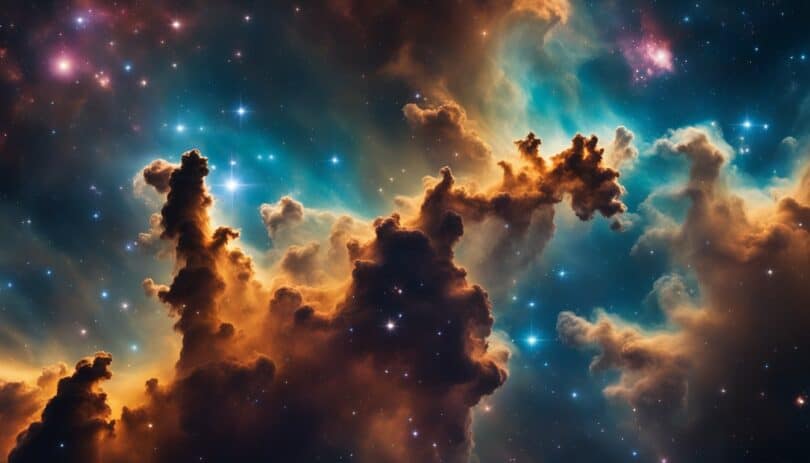When we gaze up at the night sky, the twinkling stars are not the only wonders our universe offers to our curious eyes.
Scattered among these points of light are breathtaking formations known as nebulae, which are fundamental to our understanding of the cosmos.
Nebulae are expansive clouds of gas and dust where the story of a star’s life can both begin and end. These celestial cradles are not just enchanting spectacles; they are also the focus of extensive study in the field of astronomy.
In the vast theater of the universe, nebulae play a critical role in the stellar lifecycle. They are often deemed star nurseries, regions where the gravitational pull gathers dust and gas to forge new stars.
Other types of nebulae form from the remnants of a supernova, the explosive demise of a star, marking the poignant end to a celestial giant’s existence.
Through various telescopes and space observatories, we have a window into these normally hidden processes.
Our comprehension of nebulae has evolved significantly with the advancement of technology. Observations from space telescopes like Hubble have provided spectacular imagery and invaluable insights.
By studying nebulae, we deepen our knowledge of the fundamental processes that sculpt our universe and gain a more profound appreciation for the vastness and beauty that lies beyond our planet.
With each discovery within these cosmic clouds, we uncover more about the origins of stars and possibly the secrets to our own solar system’s beginnings.
The Nature of Nebulae
Before we delve into the details, it’s essential to understand that nebulae are vast clouds of gas and dust in space, often playing a central role in the birth and death of stars. These celestial entities are composed mainly of hydrogen and helium and can vary significantly in their appearance and characteristics.
Formation and Composition
Nebulae originate from the gravitational collapse of the gases in the interstellar medium, often mixed with ionized particles and varying amounts of dust. The two primary elements found in nebulae are hydrogen and helium, which together form the cornerstone of star formation. In addition, ionized gases give rise to certain types of nebulae known as emission nebulae, where photons emitted by nearby stars energize the hydrogen ions, resulting in a distinct glow.
Molecular clouds, which are dense regions of gas and dust, serve as the breeding grounds for new stars. When these clouds collapse under their own gravity, they can fragment and initiate the process of star formation. The remaining materials often become incorporated into the stellar system or may be ejected back into the interstellar medium through processes such as stellar winds or supernova remnants.
Types of Nebulae
The universe presents us with a variety of nebulae, each with unique characteristics and origins. We can classify nebulae into several categories:
-
Emission Nebulae: These nebulae emit light of various colors due to excitation of their constituent gases—chiefly hydrogen—by the radiation from nearby stars. The iconic Hubble’s Nebulae highlight these vibrant spectacles.
-
Reflection Nebulae: In a stark contrast, reflection nebulae do not emit light on their own. Instead, these nebulae reflect the light of nearby stars. Their bluish hue is due to the preferential scattering of blue light by the dust.
-
Dark Nebulae: Sometimes called absorption nebulae, they appear as dark patches against the brighter background of the Milky Way, obscuring the light of stars behind them with their dense concentrations of dust and molecular clouds.
-
Planetary Nebulae: Despite their name, these nebulae have nothing to do with planets. They are formed from the outer layers of a dying star that are shed and driven off as the star transitions into a white dwarf.
Each of these nebulae tells a unique story about the conditions and processes that dominate the evolution of our galaxy. From the swirling mists of star nurseries to the final breath of a star’s life, these celestial forms help us unravel the mysteries of the cosmos.
Observation and Exploration
As we study the cosmos, the observation and exploration of nebulae stand as a cornerstone in our understanding of the universe. This journey has been marked by significant milestones from early telescopic views to the sophisticated imagery of current space missions.
Historical Discoveries
Nebulae have fascinated us since the advent of the telescope. In the 17th century, astronomers like William Herschel began cataloging these mysterious “cloudy” objects without understanding their true nature. Our recognition of nebulae as vast regions of gas and dust, related to the life cycle of stars, set the stage for modern astrophysics.
Modern Telescopic Advances
The introduction of telescopes like the Hubble Space Telescope (HST) revolutionized our ability to investigate the universe. HST has provided us with stunning images of nebulae, capturing their complex structures in unprecedented detail. The development of infrared technology allowed us to peer through cosmic dust and observe phenomena invisible to the naked eye.
Key Instruments:
- Hubble Space Telescope (HST) – Revealed intricate details of nebulae in visible light.
- James Webb Space Telescope (JWST) – Designed to study the universe in infrared.
Key Observations in Astronomy
Our observations have defined nebulae as more than just cosmic scenery; they’re fundamental to our understanding of stellar evolution. For example, the Eagle Nebula serves as a dynamic laboratory for studying star formation. Simultaneously, the subtleties of the Orion Nebula’s spectra have taught us about the influence of radiation on the surrounding environment. By analyzing various wavelengths, we can deduce the composition, density, and temperature of these celestial factories.
Crucial Findings:
- Starbirth and Death: Nebulae are where stars are born and where some find their end.
- Radiation Processes: The interaction between stellar radiation and nebula gas results in breathtaking imagery and valuable data for us to decode.
In our quest to explore nebulae, each mission builds upon the last, refining our techniques and expanding our knowledge. Our telescopes serve as both time machines and microscopes, allowing us to observe the ancient processes that continue to shape our galaxy.
Nebulae and Star Development
Nebulae are the cosmic cradles for star development, where gases and dust undergo dramatic transformation into nascent stars. Through complex processes involving gravity and nuclear fusion, these interstellar clouds orchestrate the birth and evolution of stars.
Stellar Nurseries
Stellar nurseries form the backbone of star creation. In these dense regions of a nebula, particles of gas and dust are pulled together by gravitational attraction, elevating the density and temperature until the conditions are ripe for star formation. The collapse of these clouds under their own gravity is a delicate balance of forces that ultimately results in the birth of new stars. As the cloud collapses, pockets of increasing density heat up, leading to the emergence of protostars — the forerunners to fully-fledged stars.
Life Cycle of Stars
We must appreciate the full life cycle of stars which begins within these nebulae. From a star’s nascent phase as a protostar to its often dramatic demise as a supernova, nebulae play a critical role. Stars like our Sun originate from the collapse of regions within nebulae, igniting to form a main sequence star. Over time, as stars exhaust their nuclear fuel, some end their lives explosively, creating supernovae that eject stellar material back into space. This ejected material, enriched with heavier elements, contributes to the complexity of the nebulae and often leads to the creation of new stars and possibly even solar systems. Additionally, the stellar winds from these events can trigger the formation of other stars, perpetuating the stellar lifecycle within these cosmic nurseries. Clusters of stars are often found within these regions, having formed from the same dense cloud of stellar material.


